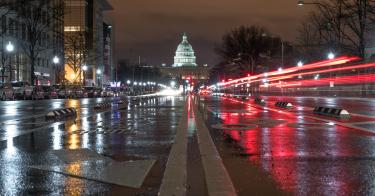"Government shutdown." Probably no two words strike more fear in the hearts of Washington politicians.
The fact that another shutdown is imminent is a sign of how dysfunctional Washington's budgeting process really is. What was once an orderly process where timelines were largely met has morphed into a political game plagued by brinkmanship and out-of-control spending.
Despite promises from Congress that the process would be different this year, here we are again.
This time the biggest issue holding up a deal is a confrontation between President Donald Trump and congressional Democrats over border-security funding.
As Congress barrels towards a Friday spending showdown, the potential of a partial government shutdown is very real. But what would it actually mean?
A shutdown wouldn't be good, of course, but it's not as scary as you think. There wouldn't be lawlessness in the streets. You'd still get your Social Security check.
Here's what a shutdown and an alternative might look like:
GOVERNMENT SHUTDOWN
If Congress and the president are unable to reach an agreement by Friday, then the federal government will enter into a partial shutdown. Five of 12 annual spending bills became law in September. That includes the military, so there is no threat to national defense.
It also includes the Departments of Labor, Health and Human Services, Interior, and Veterans Affairs. In fact, 75 percent of the discretionary budget has already been funded through September 2019.
Still, a partial shutdown would mean that major federal agencies such as the Departments of Agriculture, Commerce, Justice, Homeland Security, State, and Transportation would be left without funding.
Many of the services they provide, however, would not be interrupted. 420,000 "essential" federal employees would continue to work, including 41,000 law enforcement and correctional officers and up to 88 percent of DHS employees. America's safety would not be sacrificed.
You shouldn't worry about your benefit payments being impacted either. Social Security, Medicare and Medicaid payments, as well as veterans benefits, would continue uninterrupted. These programs don't rely on Congress taking action for annual funding to continue, or their appropriations were already passed into law.
Mail service would also continue as scheduled since the postal service has its own revenue stream. National parks would remain open, though with reduced staff.
About 380,000 federal employees would be furloughed for the duration of a shutdown, meaning that they wouldn't be paid nor expected to work. Agencies that would be most affected include the Department of Commerce, NASA, the IRS, and HUD. Based on past government shutdowns, all furloughed employees would likely be paid when the shutdown ends.
A CONTINUING RESOLUTION
Another possible outcome to get around the current funding impasse is for Congress to pursue a continuing resolution to keep the government open. That scenario played out as the last funding deadline approached on Dec. 7.
Under this situation, agencies would operate at their 2018 budget levels for the duration of the continuing resolution. Congress could choose to extend funding for a short period of time (likely into early 2019) or could opt for a full-year continuing resolution.
If Congress passes a short-term continuing resolution, then they would be back in the same mess in just a few short weeks.
Passing a full-year continuing resolution would put an end to the budget drama for this year. However, it would also leave both Republicans and Democrats unsatisfied, with Trump not getting additional border security money and Democrats unable to enact some of their priorities.
But it would save taxpayers money. If unfunded agencies simply continued to receive money at the 2018 level, it would cut spending by $11 billion.
It's not a lot, but with the national debt soon expected to cross $22 trillion, every penny counts.
Regardless of what happens, one thing is clear: The budget process is broken, and taxpayers are the real losers. When Congress is constantly budgeting by crisis, it erodes oversight and leads to wasteful spending. Citizens should demand that Congress not only make the budget process better, but also ensure a sustainable budget future.
The cost of failing to do that is much scarier than a government shutdown.
This piece originally appeared in Madison.com



